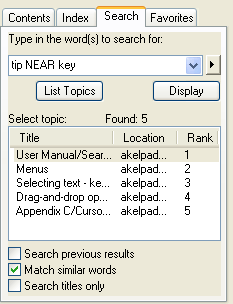Using Search Effectively
Click or Hover on an item for more ...

This electronic book (Explorer++ - Help File) contains a great
deal of information about the program and its use. The manual is organized
using menus and topics, but it may sometimes be difficult to find the right
information! This book's Search tab can help in this regard, but
Search has more power than might be evident on the surface.
Following are some hints for using Search effectively.
| use HIGHLIGHT |
On the tool bar, click Options and make sure that the
Search Highlight feature is ON. If the menu item says "Search
Highlight Off", then the feature is already enabled. This feature will
highlight
items in the text that are found by the search.
|
| use WILDCARDS |
The search utility normally looks for words (or phrases) as-is
(not case sensitive). This means that a search for the word
divide will not find any occurrences of
the word divides Use wildcards to
expand your search:
| |
* |
including an asterisk (ie. *) somewhere in the search target finds
more combinations of the target, just as it does from a DOS (or Command)
prompt. The asterisk stands for any (optional) multiple
characters. Using divid* as
the target finds
divide,
divided
and
dividing as well. The search target
*divid* finds all the previous, plus
will find
individual, etc. |
| |
? |
including a question mark somewhere in the search target finds any
(mandatory) single character in that position. Using
divide? as the target finds
divides,
divider
and
divides but won't find
divide or
dividing. |
Enabling the Match similar words option will help to find plurals,
etc., but a wildcard search can be more versatile.
|
| use PHRASES |
Searching for ctrl key finds
occurrences of both words in the same topic, but not necessarily together!
Using "ctrl key" (enclosed in double
quotes) treats it as a phrase and only finds that phrase.
Quotation characters cannot be found using the search, since they enclose a
phrase. Note that when searching for file names with extensions (eg.
EXPLORER++.EXE), use a phrase also (eg.
"EXPLORER++.EXE") otherwise the period
will separate the search into 2 distinct words.
|
| use BOOLEANS
 |
If you are looking for more than one word (or phrase), you may separate
them with one of the reserved boolean words to restrict your search:
| |
AND |
Topics must contain both words, eg. tip AND
key will only find topics containing both words
or phrases. Note that tip AND key
is equivalent to tip key . |
| |
OR |
Topics may contain either word or both words.
Searching for ctrl
OR alt finds topics containing either or both of the words,
anywhere in the topic. |
| |
NOT |
Topics may not contain the word or phrase following NOT, as in
ctrl NOT alt, which will find
occurrences of
ctrl, providing
alt is not found on the page. |
| |
NEAR |
Topics must contain both words or phrases, but close together.
A search for macro NEAR user will
find phrases containing both words, but will not find pages where the
words are far apart. This search mode is not effective
where pages/topics are short, since close together and far
apart are not precise terms; NEAR works best on larger
documents or pages. |
|
Searching in the Document pane
Once you are reading a particular page, it is also possible to search for a
word or phrase within that page by:
- clicking the mouse on the right-hand pane (ie. the actual page you are
reading), preferably near the start of the page. This sets Windows' focus on
the text, although usually no visible change is evident.
- press <ctrl>F to initiate the Find dialog
- follow the instructions in the dialog (simple search options)
Unfortunately, the search highlight color in the document pane is not
changeable; highlighting words which are already written in the highlight color
(or close) renders them difficult - but not impossible - to see.
 |
|
|
Tip: If a global search has been done which
highlights certain phrases or words, and a search within that page follows
which uses the same words, the highlight colors may not be as expected.
A work-around to this behavior is to turn off search highlighting (using the
Options button on the Help file's toolbar) and reload the page by
re-selecting it from the original global search results. |




